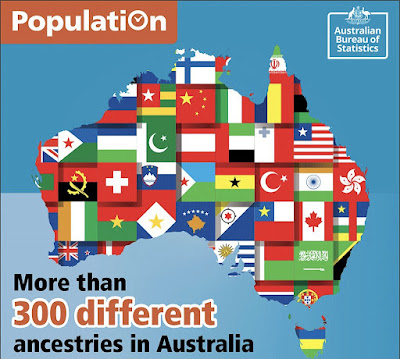Unsurprisingly, with Covid restrictions in place across much of the nation, 96% of people were at home on census night, an increase of 2 million people compared with 2016.
Australia’s overall population increased by 2.2 million, or 8.6 per cent, to 25.5 million between the 2016 and 2021 censuses. The number of Indigenous Australians increased by 25.2 per cent over the same period to more than 812,000.
Almost half of Australians have a parent born overseas and more than a quarter of Australian residents were born outside the country.
Mandarin continues to be the most common language, other than English, with nearly 700,000 people speaking it at home. This is followed by Arabic. Punjabi had the largest increase.
Boomers and Millennials now each account for 21.5 per cent of the nation’s 25.5 million residents.
For the first time, more than 1 million families in Australia are headed by a single parent – and in most cases this parent is female.
Of 5.55 million families recorded in 2021 census data nearly 1.07 million are single-parent families, and in four out of five of those, the parent is the mother.
While Christianity is still the most common religion in Australia, religious diversity is increasing: 39% of respondents identified as Christian in the 2021 census compared to more than half in 2016 and 61% in 2011.
At the same time, more people are identifying as atheist or agnostic. Almost 40% of the population responded “no religion” on the 2021 census, an increase of 10% in the past five years.
Interestingly, while almost 60% of baby boomers reported a religious affiliation, 46.5% of millennials reported having no religion.
The majority of Australians still live in houses, but alternative living arrangements are on the rise: 58,155 filled out the census from a caravan, while 29,369 people were in a cabin or a houseboat and more than half a million were in a high rise apartment.
Of nearly 11 million private dwellings counted in the census, separate houses accounted for 70%, apartments 16%, and townhouses made up 13%.
Two-thirds of households own their home outright or with a mortgage, similar to the rate in 1996. But the proportion of households that own outright has dropped to 31%.
The census data shows more than 8 million people have a long-term health condition, including about 2.2 million (roughly one in 12 people) who have a diagnosed mental illness.
A further breakdown of the data reveals almost 16 percent of the population now have a long-term diagnosis for back pain, which has emerged as the second most common chronic health condition nationally, followed by arthritis.
Diabetes also remained a major chronic health issue with 5.3 percent of the population reporting a diagnosis. Of these, 0.6 percent were Type 1 diabetes and 4.5 percent were Type 2 diabetes.
In the increasingly fraught area of unpaid domestic labour, the 2021 census showed Australian women do vastly more household chores than their male counterparts.
Overall, nearly 1.4 million women said they do 30 hours or more of domestic work a week, compared with 394,995 men.
Twice as many women (nearly 1.7 million) said they did 15 to 29 hours a week of home chores compared with men (nearly 820,000).























